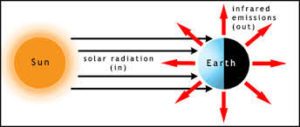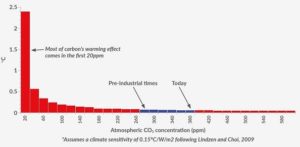Terry Brosnahan
Methane and nitrous oxide are not the villains when it comes to climate change and should be removed from New Zealand’s greenhouse gas inventory.
That’s the view of two scientists who have released a research paper reviewing the science on greenhouse gases (GHG).
Dr Thomas Sheahen and Dr Jock Allison argue water vapour and clouds are responsible for 80-90% of the GHG effect.
Water vapour and clouds from natural resources, not man-made are absorbing heat and warming the planet. Methane and nitrous oxides contribute very little to warming the planet. Carbon dioxide does have an impact but not to the extent the IPCC and supporting scientists claim.
Allison, is a consultant and former MAF director agricultural research for the southern South Island, Sheahen is chairman of the Science and Environmental Policy project in Virginia, United States. Professors Will Harper (US) and William van Wijngaarden (Canada) advised them on their paper. They say the evidence shows the contribution of methane and nitrous oxide to global emissions is negligible. Allison is a member of the NZ Climate Science Coalition and calls himself a climate realist.
The New Zealand Government wants to move to a zero carbon economy by 2050. A bank report puts an early transition at a cumulative economic benefit of about $30 billion by 2050.
‘It doesn’t look like much warming over nearly 20 years.’
However, an AgFirst rural economist Phil Journeau told the NZ Farmers Weekly recently it will cost the economy more than a trillion dollars in GDP foregone over the 32 years. Two million hectares of pastoral land will be lost to trees under the Productivity Commission report proposals.
NZ’s share of global emissions is estimated to be about 0.17% of the world emissions and critics argue a carbon zero goal will make no difference.
Allison and Sheahen say methane and nitrous oxides are classified as half of NZ’s total emissions but are insignificant compared to carbon dioxide. The Intergovernmental Panel on Climate Change (IPCC) accept water vapour is responsible for 70% of greenhouse gases, yet doesn’t include water vapour and only focuses on human emissions.
The earth is warmed by incoming sunlight and cooled by outgoing infrared emissions at night (fig 1).

Heat from the surface is radiated back, absorbed by various greenhouse gases (mainly water vapour) and transported by convection and moist air to the upper troposphere (lowest part of the atmosphere) where clouds form.
The global warming potential (GWP) is a calculated ratio the IPCC uses to estimate the heat each greenhouse gas absorbs in the atmosphere. It is all brought back to carbon dioxide hence CO2 emissions which the UN says is a base of 1 and methane 21 and nitrous oxide 310.
Allison and Sheenan say GWP is a concept developed by the IPCC and accepted by world governments as the basis for calculating greenhouse inventories.
Allison says methane and nitrous oxide can’t absorb the incoming heat from the sun at the wavelength it comes in on. Solar radiation (energy) comes in at 0.2 to 0.3 microns and goes out as thermal radiation at 3-70 microns. Heat is absorbed from the surface by the various greenhouse gases, mainly water vapour and to a lesser extent carbon dioxide.
Also the individual greenhouse gases – water vapour, carbon dioxide, nitrous oxide and methane are similar-size molecules with similar heat absorptive capacity.
Allison says the atmosphere temperatures from 1998 to January 2016 have not increased, according to data from the University of Alabama in Huntsville, US.
“It doesn’t look like much warming over nearly 20 years.”
He says the IPCC refuses to discuss the balloon and satellite data.
“They prefer to concentrate on the mostly corrupted land temperature records which satisfy their political masters.”

Allison says atmosphere measurements by satellite and weather balloons cover 90% of the world and doesn’t have the problem of urban heat islands – cities and airports where climate stations are based.
“Neither are satellite records adjusted in such a way as to artificially exacerbate warming.”
Allison says about one third of all the human emissions ever have been over the past two decades.
“You would expect the temperature to go through the roof.”
Climate control
The Paris 2015 Climate Change agreement set a target of a global temperature not rising above 2C (for post-industrial times) and ultimately 1.5C.
Allison says about 62% of world emissions are from developing countries and under Paris agreement they are allowed to keep developing.
Developed countries like NZ have 38% of the total emissions of which the US has 14.6%. This leaves the rest of the developed world with 23.4% to make contributions, to carry the cost of reducing emissions. China says it will double total emissions by 2030 (29.5%)
India says it will triple emissions from 6.8% to 13.6 plus by 2030.
Other countries say will increase by 10%.
“And the IPCC thinks they can control the climate.”
Allison says other developing countries are increasing their standard of living which is all about about cheap energy (not wind and solar which is less than 1.5% of world’s energy).
He recalls going to a scientific meeting in Auckland in 1979 where they were told world oil stocks would run out by 2000.
“The world is not going to run out of oil anytime soon.”
Australia is the biggest coal exporter in the world (36%) but politically they don’t want to burn coal for electricity.
“They are awash with energy options but many states ban fracking for gas and don’t want nuclear.
“They are crazy.”
So what should we be doing?
Allison says to watch what is happening.
“We should wait and see what happens as we are working on real data.”
He says nobody knows what will happen with the climate. We could get cooling.
“The IPCC and member governments are projecting through to 2100 and beyond, but what they are predicting is not happening.
“The predictions are based on computer models obviously not fit for purpose.”
Allison says climate change minister James Shaw believes a carbon zero economy is a huge economic opportunity for agriculture because people will pay major premiums for products.
“Good luck with that.”
High flyers
About 30,000 delegates from around the world attended the recent United Nations climate change conference. Apart from the cost of the conference, there was also the carbon emissions.
Using an online carbon emissions calculator, a return trip from Wellington to Warsaw is 35,900km or 6.8 tonnes of carbon dioxide per passenger. So taking an average of four tonnes CO2/person that is another 120,000t of carbon emissions pumped into the atmosphere. Aviation emissions is touted as one of the fastest-growing sources of emissions. About 20,000 commercial passenger planes are reported to be flying in the world which is expected to double by 2040.
Global aviation emissions are expected to rise anywhere from 300-700%.
- Read full report at https://tinyurl.com/y9dkl4ox




